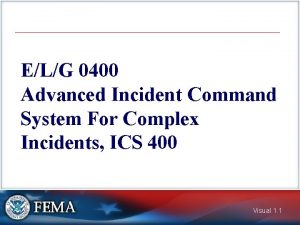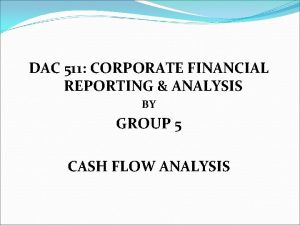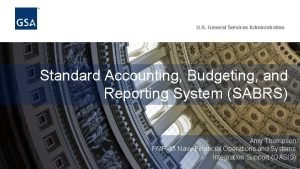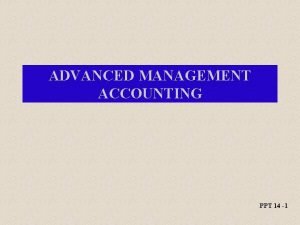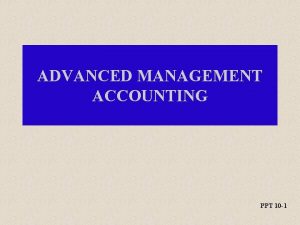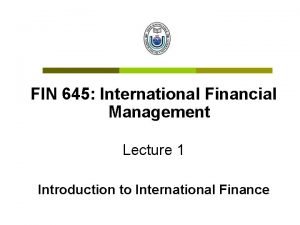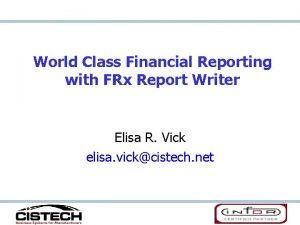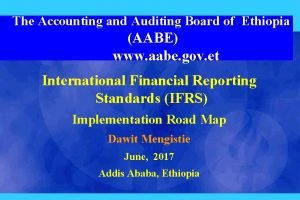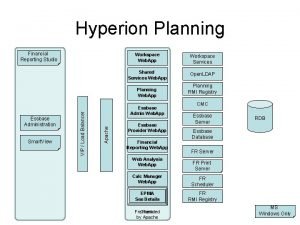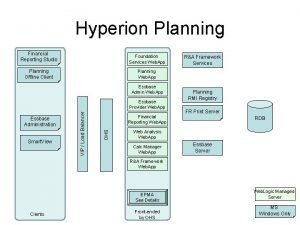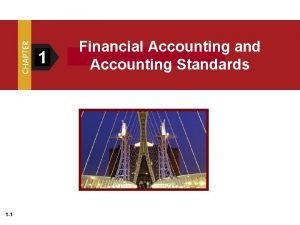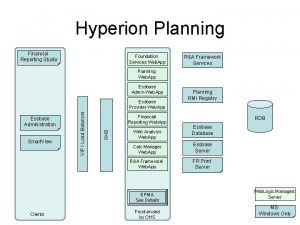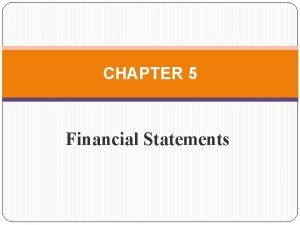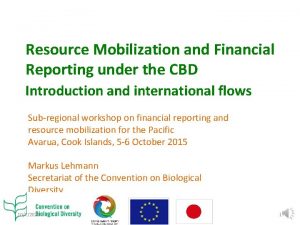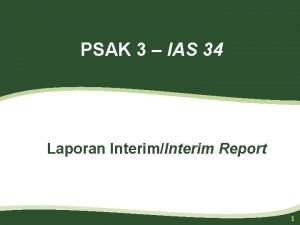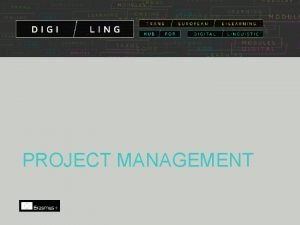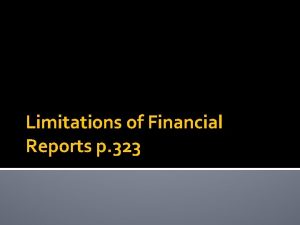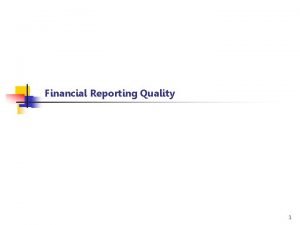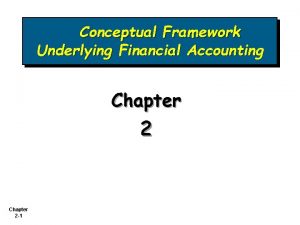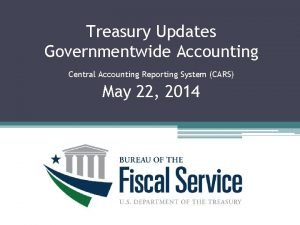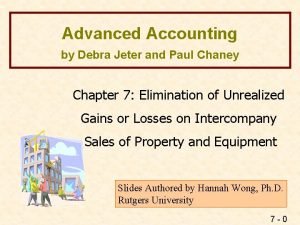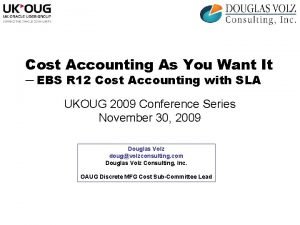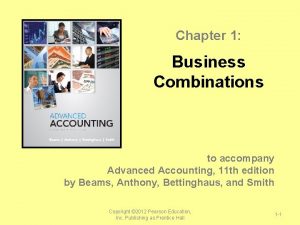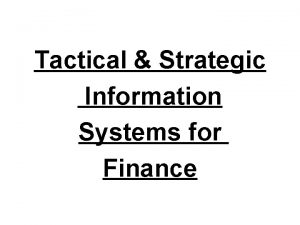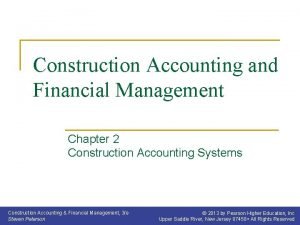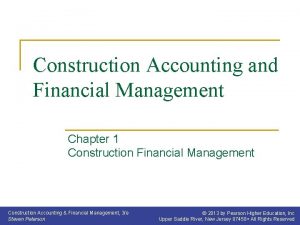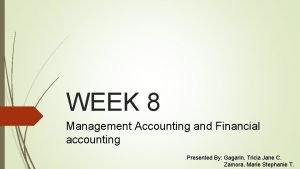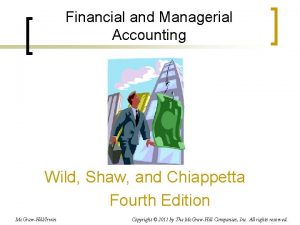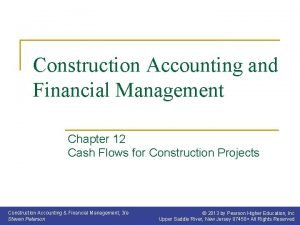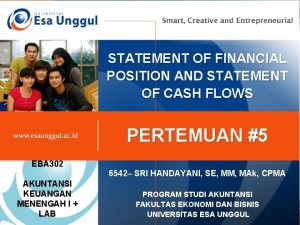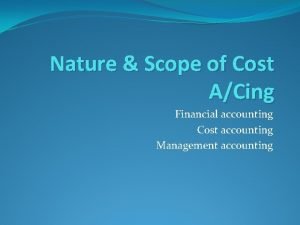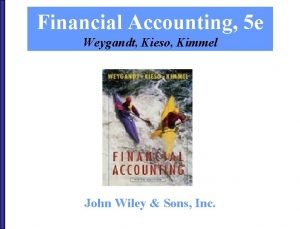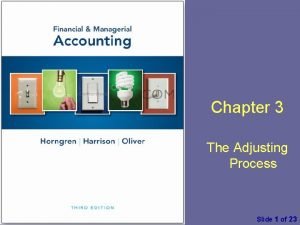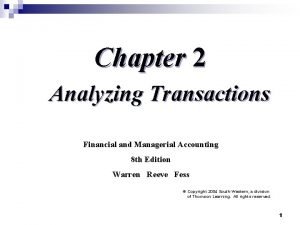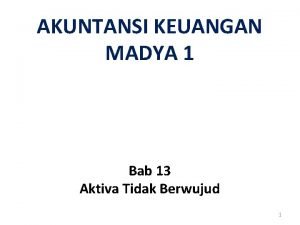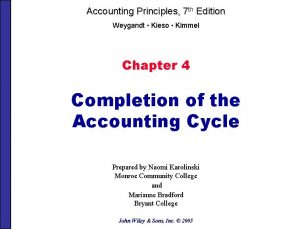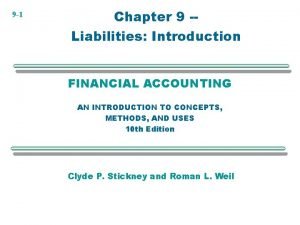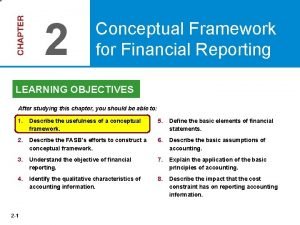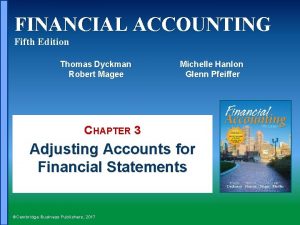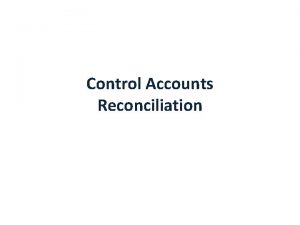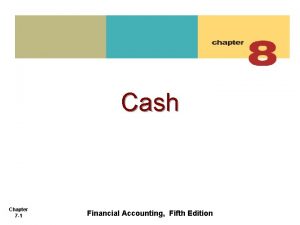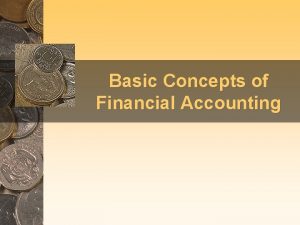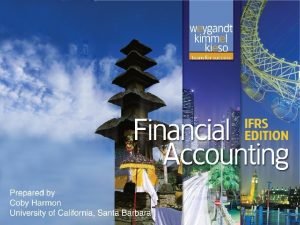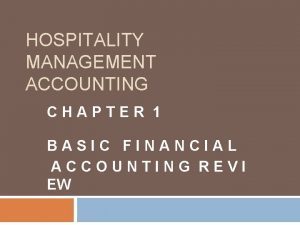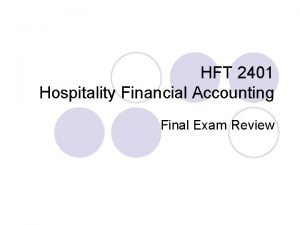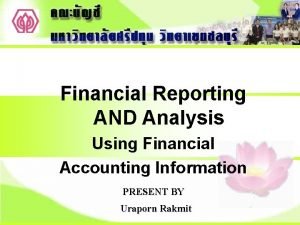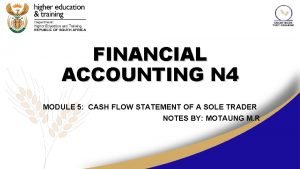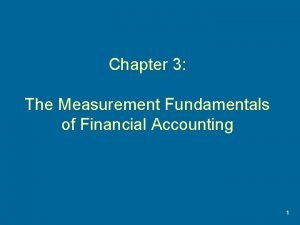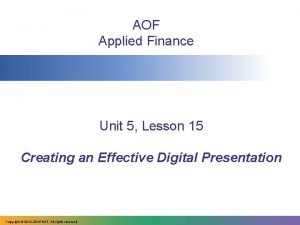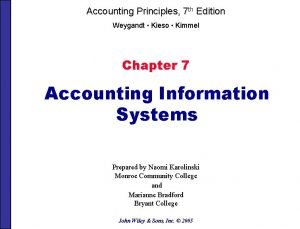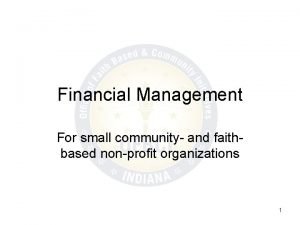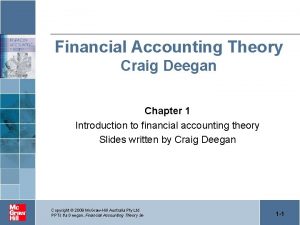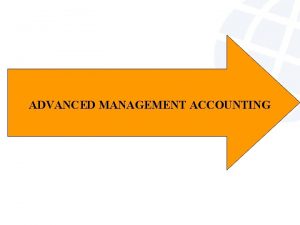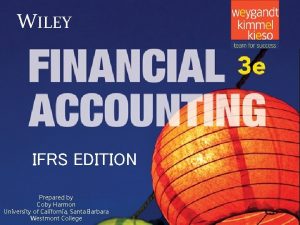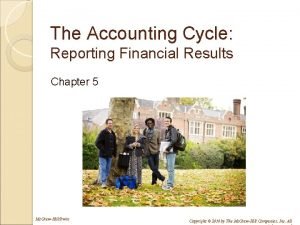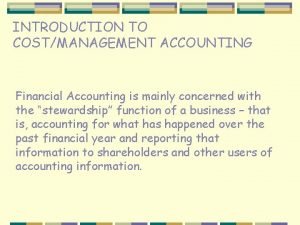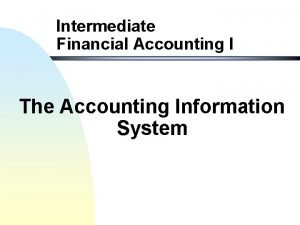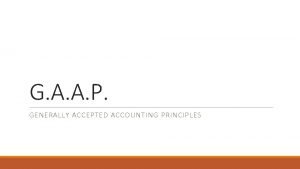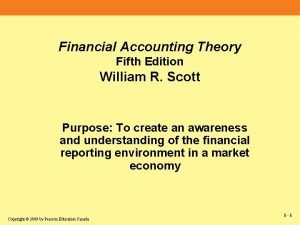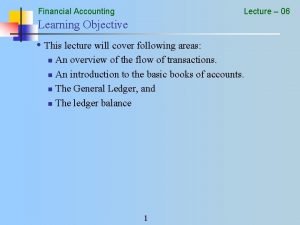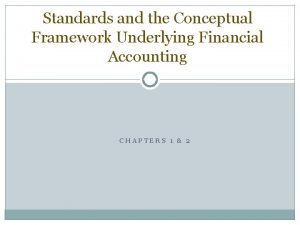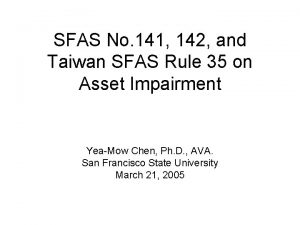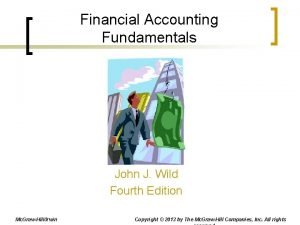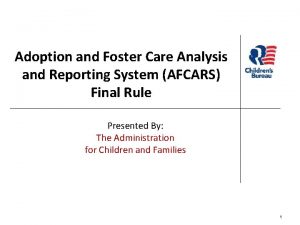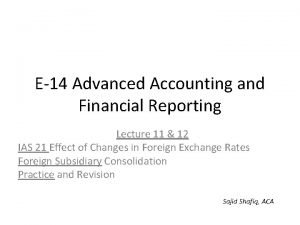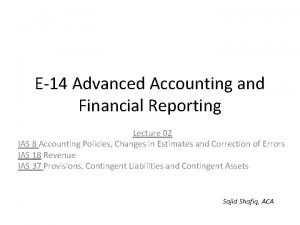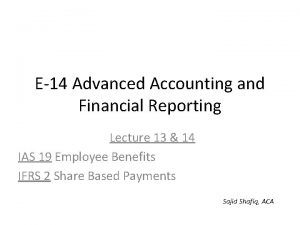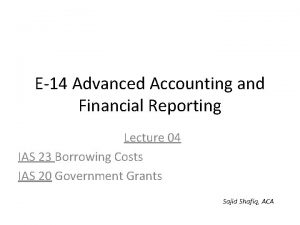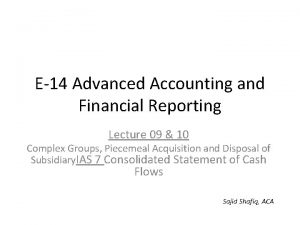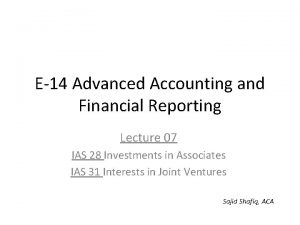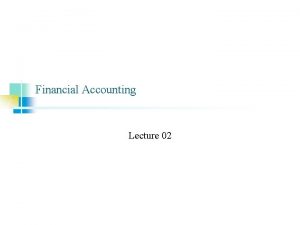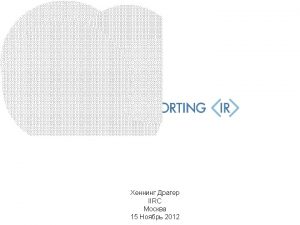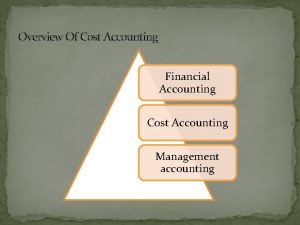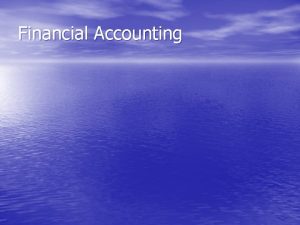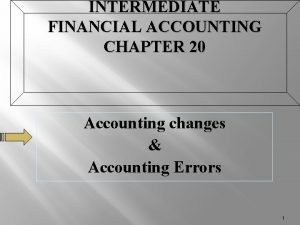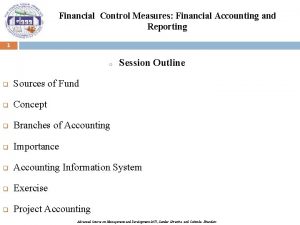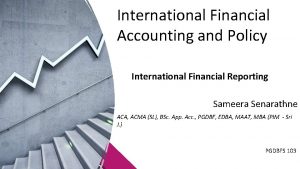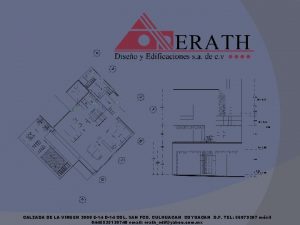E14 Advanced Accounting and Financial Reporting Lecture 05
































































































- Slides: 96

E-14 Advanced Accounting and Financial Reporting Lecture 05 & 06 IAS 27 Consolidated and Separate Financial Statements IFRS 3 Business Combinations Sajid Shafiq, ACA

IAS 27 -Overview • Introduction to Group Accounts • Consolidated Statement of Financial Position of a Subsidiary • Consolidated Statement of Comprehensive Income of Subsidiary (Income Statement) • Consolidated Statement of Changes in Equity • Regulatory Framework IAS 27 Consolidated and Separate Financial Statements 2

Introduction to Group Accounts FS normally set out the financial position and performance of a single entity. If that entity is controlled by (or controls) another entity (its parent or subsidiary respectively) and there are intra-group transactions, then its FS may not reveal a true picture of its activities. Consolidated Financial Statements(CFS) are prepared on the basis that the group is a single economic entity, by aggregating the transactions and balances of the parent and all its subsidiaries. A group is simply a collection of entities, where one, the parent, controls the activities of the others, its subsidiaries. The preparation of single entity FS would not reflect the economic reality of the financial performance and position under the control of the parent entity. IAS 27 Consolidated and separate financial statements governs the preparation of CFS of Parent and Subsidiaries and is discussed in this Lecture. The treatment in the CFS for investments giving rise to joint control (under IAS 31 Interests in joint ventures) and for those giving rise to significant influence (under IAS 28 Investments in associates) are dealt with in Lecture 07. IAS 27 Consolidated and Separate Financial Statements 3

Consolidated Statement of Financial Position(CSFP) of Subsidiary • The Rationale, Conceptual Background and Overview of the Technique • The Basic Principles… – Goodwill, – Non Controlling Interest and – Consolidated Retained Earnings • Complications… – Mid Year Acquisition, – Inter company trading • Further Adjustments … – Items not accounted for – Group accounting policy adjustment – Goodwill (Accounting, Revaluation of Subsidiary’s accounts, ) IAS 27 Consolidated and Separate Financial Statements 4

CSFP of a Subsidiary The rationale • Many companies carry on part of their business through the ownership of other companies which they controlknown as subsidiaries • Controlling interests in such companies would generally appear at cost in the accounts of the investing company. • Such interests may result in the control of assets of a very different value to the cost of investment. • In other words, the accounts will not provide the shareholders of the parent company with a true and fair view of what their investment actually represents. The substance of the relationship is not reflected in the accounts. IAS 27 Consolidated and Separate Financial Statements 5

Consolidated SFP of a Subsidiary The rationale-Illustration Parent Subsidiary Investment in 100% shares of Subsidiary 15, 000 Other Net Assets 45, 000 25, 000 60, 000 25, 000 Share Capital 20, 000 10, 000 Reserves 40, 000 15, 000 60, 000 25, 000 § § The Investment of 15, 000 is, in substance, the cost of owning assets of 25, 000. Parent’s shareholder can not see this looking simply at Parent Co’s accounts. The Solution is to prepare Group Accounts (Consolidated Financial Statements) to reflect this substance IAS 27 Consolidated and Separate Financial Statements 6

Consolidated SFP of a Subsidiary Conceptual Background • Consolidation involves ‘replacement’ of cost of investment in the Parent’s accounts by what it actually represents i. e. – Parent’s share of the net assets of the Subsidiary as at the reporting date AND – Any remaining element of goodwill which the parent paid for at the date of acquisition • In addition to this, the reserves of the parent must be credited with parent’s share of the subsidiary’s post acquisition reserves… so that the accounts balance IAS 27 Consolidated and Separate Financial Statements 7

Consolidated SFP of a Subsidiary Overview of the Technique Individual Co. Adjustments Consolidated Subsidiary xxx Current Assets xxx Equity xxx Non Current Liabilities xxx xxx xxx o Adju lidation stme nts Non- Current Assets +Cons Parent IAS 27 Consolidated and Separate Financial Statements xxx xxx 8

Consolidated SFP of a Subsidiary The Basic Principles Example 1 As at 31 December 2010 Parent (000) Subsidiary(000) Property, Plant & Equipment 20, 000 Cost of Investments in S 10, 000 Net Current Assets 20, 000 50, 000 10, 000 5, 000 10, 000 Share Capital Retained Earnings 5, 000 45, 000 50, 000 10, 000 Parent purchased 100% of Subsidiary’s shares on 31 December 2010. IAS 27 Consolidated and Separate Financial Statements 9

Consolidated SFP of a Subsidiary The Basic Principles Example 1 Points to Note: 1. The share capital of the Group is always the share capital of the Parent. This is always the case 2. The Cost of Investment in Subsidiary will disappear. It is ‘replaced’ 3. The assets and liabilities of the Group are simply the sum of those of Parent and Subsidiary. IAS 27 Consolidated and Separate Financial Statements 10

Consolidated SFP of a Subsidiary The Basic Principles Solution: 1 As at 31 December 2010 Consolidated SFP Property, Plant & Equipment Cost of Investments in S Net Current Assets Share Capital (Parent Co only) 5, 000 Consolidated Retained Earnings IAS 27 Consolidated and Separate Financial Statements 11

Consolidated SFP of a Subsidiary The Basic Principles This is the simplest of examples. • Cost of Investment EQUALS share of net assets. i. e. there is no Goodwill • Consolidation is AT the date of acquisition • Parent owns 100% of Subsidiary These simplifications will now be relaxed one by one. IAS 27 Consolidated and Separate Financial Statements 12

Consolidated SFP of a Subsidiary The Basic Principles Workings: 1. Goodwill Cost of Investment Less Share of* Net Assets at ACQUISITION date 2. Consolidated Retained Earnings Parent’s Plus Share of Subsidiary’s Post acquisition Retained Earnings IAS 27 Consolidated and Separate Financial Statements * An alternative method of Full GW will be discussed later 13

Consolidated SFP of a Subsidiary The Basic Principles- Goodwill Example 2 As at 31 December 2010 Parent (000) Subsidiary(000) Property, Plant & Equipment 20, 000 Cost of Investments in S 15, 000 Net Current Assets 15, 000 7, 000 50, 000 12, 000 5, 000 10, 000 45, 000 2, 000 50, 000 12, 000 Share Capital Retained Earnings 5, 000 Parent purchased 100% of Subsidiary’s shares on 31 December 2010. IAS 27 Consolidated and Separate Financial Statements 14

Consolidated SFP of a Subsidiary The Basic Principles-Goodwill Example 2 Points to Note: 1 to 3 as above 4. Part of the cost is goodwill. This must be separately identified IAS 27 Consolidated and Separate Financial Statements 15

Consolidated SFP of a Subsidiary The Basic Principles-Goodwill Solution: 2 As at 31 December 2010 Consolidated SFP Property, Plant & Equipment Goodwill Net Current Assets Share Capital 5, 000 Consolidated Retained Earnings IAS 27 Consolidated and Separate Financial Statements 16

Consolidated SFP of a Subsidiary The Basic Principles- Post Acquisition reserves Example 3 As at 31 December 2010 Parent (000) Subsidiary(000) Property, Plant & Equipment 20, 000 Cost of Investments in S 15, 000 Net Current Assets 15, 000 8, 000 50, 000 13, 000 5, 000 10, 000 45, 000 3, 000 50, 000 13, 000 Share Capital Retained Earnings 5, 000 Parent purchased 100% of Subsidiary’s shares on 31 December 2009 when subsidiary’s reserves stood 2, 500. IAS 27 Consolidated and Separate Financial Statements 17

Consolidated SFP of a Subsidiary The Basic Principles-Post acquisition reserves Example 3 Points to Note: 1 to 4 as above 5. Parent’s share of the post acquisition profits of Subsidiary is included in the consolidated retained earnings. IAS 27 Consolidated and Separate Financial Statements 18

Consolidated SFP of a Subsidiary The Basic Principles-Post acquisition reserves Solution: 3 As at 31 December 2010 Consolidated SFP Property, Plant & Equipment Goodwill Net Current Assets Share Capital 5, 000 Consolidated Retained Earnings IAS 27 Consolidated and Separate Financial Statements 19

Consolidated SFP of a Subsidiary The Basic Principles- Less than 100% shareholding Example 4 As at 31 December 2010 Parent (000) Subsidiary(000) Property, Plant & Equipment 20, 000 Cost of Investments in S 16, 000 Net Current Assets 14, 000 8, 000 50, 000 13, 000 5, 000 10, 000 45, 000 3, 000 50, 000 13, 000 Share Capital Retained Earnings 5, 000 Parent purchased 80% of Subsidiary’s shares on 31 December 2009 when subsidiary’s reserves stood 2, 500. IAS 27 Consolidated and Separate Financial Statements 20

Consolidated SFP of a Subsidiary The Basic Principles-Less than 100% shareholding Example 4 Points to Note: 1 to 3 and 5 as above. However, it is important to note that • ALL the assets and liabilities of the subsidiary shall be added IRRESPECTIVE of the percentage of shareholding. • The percentage in net assets not owned by the parent is shown separately as “Non-controlling Interest” in SFP as a credit balance. • The effect on Goodwill (point 4 above) calculation, after IFRS 3 revised has become a bit tricky. See next slide IAS 27 Consolidated and Separate Financial Statements 21

Consolidated SFP of a Subsidiary The Basic Principles-Less than 100% shareholding Example 4… IFRS 3 (Revised) & Effect on Goodwill calculation. • Traditionally, Goodwill was calculated as being excess of Cost of investment by Parent over share of net assets of Subsidiary at acquisition date (as explained in 4 above, called proportionate GW method) • It has long been argued that the traditional method only recognizes the goodwill purchased by the parent rather than the goodwill controlled by it. • IFRS 3 (Revised) now requires that any goodwill attributable to the NCI should also be recognized. (Full GW method). However, proportionate GW is also permitted. IAS 27 Consolidated and Separate Financial Statements 22

Consolidated SFP of a Subsidiary The Basic Principles-Less than 100% shareholding Example 4… IFRS 3 (Revised) & Effect on Goodwill calculation. There a number of ways of presenting the information to test the new method: i. Stating nothing. This would imply that goodwill for parent shall be increased proportionately with credit to NCI. (as in example 4 above) ii. The subsidiary’s share price just before the acquisition could be given and then used to value the NCI. It would then be a matter of multiplying the share price by the number of shares held by the NCI. Note that the parent is likely to have paid more than the subsidiary’s pre-acquisition share price in order to gain control. (say 15 Rs per share for example 4) iii. The question could simply state that the directors valued the NCI at the date of acquisition at a particular value. (say 3, 000) iv. An alternative approach would be to give (in the question) the value of the goodwill attributable to the NCI. In this case, the NCI’s goodwill would be added to the parent’s goodwill (calculated by the old method) and to the carrying amount of the NCI itself. ( say 1, 000) Practice each alternative!! IAS 27 Consolidated and Separate Financial Statements 23

Consolidated SFP of a Subsidiary The Basic Principles-Less than 100% shareholding Solution: 4 As at 31 December 2010 Consolidated SFP Property, Plant & Equipment Goodwill Net Current Assets Share Capital 5, 000 Consolidated Retained Earnings Non Controlling Interest IAS 27 Consolidated and Separate Financial Statements 24

Consolidated SFP of a Subsidiary Complications-Mid Year Acquisition, • A parent may acquire subsidiary during the year. In that case, it is necessary to calculate net assets at the date of acquisition. • Unless stated otherwise, it is assumed that subsidiary’s profits accrue evenly over time. IAS 27 Consolidated and Separate Financial Statements 25

Consolidated SFP of a Subsidiary Complications-Mid Year Acquisition, Example 5 Parent acquired 100% of Subsidiary at 31 May 2010 for 200, 000. Subsidiary’s net assets as at 31 December 2007 were: Share Capital 10, 000 Retained Earnings 150, 000 160, 000 During the year ended 31 December 2010 subsidiary made a profit after tax of 60, 000. Required: 1. Calculate subsidiary’s net assets at acquisition date 2. Calculate Goodwill 3. Calculate subsidiary’s profits to be included in the consolidated retained earnings 4. What would be the effect on goodwill if percentage holding is reduced to 80%, other things remaining the same. IAS 27 Consolidated and Separate Financial Statements 26

Consolidated SFP of a Subsidiary Complications-Inter-Company trading • Inter-Company Balances • Unrealized profits • Non-current assets transfer IAS 27 Consolidated and Separate Financial Statements 27

Consolidated SFP of a Subsidiary Complications-Inter-Company trading • Inter-Company Balances – Group accounts represent performance and position of group of companies as if they were a single entity. – If the group companies have outstanding balances from/to one another, these should be cancelled out at the time of consolidation as adding these in respective assets/liabilities of group would be misleading. – In case there are in-transit cash, inventory or other unrecorded items, these have to be accounted for before the cancellation, in the books of entity which ultimately has to record the effect of transaction. IAS 27 Consolidated and Separate Financial Statements 28

Consolidated SFP of a Subsidiary Complications-Inter-Company trading • Unrealized profits – If a member of group sells inventory to another member which remains unsold/unconsumed at year end: • Seller would have recorded the profit which the ‘group’ has not realized as yet (on unsold inventory only) • Purchases would be showing the inventory at a value above that what it cost to the group – The element of URP needs to be eliminated from value of consolidated inventory. The corresponding effect may either be • Given to consolidated retained earnings, ignoring the direction of transaction (parent to subsidiary or subsidiary to parent), or • Given to the retained earnings of the SELLER. i. e. allocated to NCI as well if the sale is by subsidiary. Here, direction of the transaction is relevant. – The URP is calculated on UNSOLD inventory only, taking care of Mark up or Margin ratios given in the question – Care must also be taken if inventory in the BUYER’s account is appearing at NRV. The easy approach for examination would be to reverse the effect of NRV adjustment first, and then to proceed in the normal way. IAS 27 Consolidated and Separate Financial Statements 29

Consolidated SFP of a Subsidiary Complications-Inter-Company trading • Unrealized profits Example 6 Parent, owning 80% shares of Subsidiary made sale of 120, 000 at margin of 20%. One third of which remained unsold at year end. Required: 1. Calculate unrealized profit to be eliminated from inventory and adjustment required. 2. The mark up percentage in this transaction. 3. What adjustment would have been required if inventory were stated at 35, 000 (NRV) 4. Ignoring ‘ 3’ what if the sale had been made by subsidiary to the parent. IAS 27 Consolidated and Separate Financial Statements 30

Consolidated SFP of a Subsidiary Complications-Inter-Company trading • Unrealized profits Solution 6 1. Unrealized profit to be eliminated from inventory and adjustment required. 2. The mark up percentage in this transaction. 3. In case of NRV adjustment 4. If the sale had been made by subsidiary to the parent. IAS 27 Consolidated and Separate Financial Statements 31

Consolidated SFP of a Subsidiary Complications-Inter-Company trading • Non-current assets transfer – The intra-group profit or loss should be removed. – The additional factor as compare to sale of inventory is ‘correction of depreciation charge’ Example 7 Parent, owning 80% of subsidiary sold a plant to subsidiary at 20, 000 which had a book value in the books of Parent of 15, 000. Subsidiary charged 20% depreciation on this purchased plant. Required: Calculate consolidation adjustment IAS 27 Consolidated and Separate Financial Statements 32

Consolidated SFP of a Subsidiary Complications-Inter-Company trading Solution 7 • Adjustment -Group • Adjustment in the books of Subsidiary IAS 27 Consolidated and Separate Financial Statements 33

Consolidated SFP of a Subsidiary Further Adjustments-Items not accounted for This covers, for example, deferred tax, lease, in transit items, dividends etc. . • Proposed Dividends…. – Record by reducing retained earnings and increasing current liability – If declared by subsidiary: • There should be recorded a corresponding ‘receivable’ in the books of parent, being the recipient by increasing consolidated retained earnings • The intra-group receivable & payable shall be cancelled out, leaving only proposed dividend to NCI. This is shown as part of current liabilities and NOT as NCI – Read information given carefully. Examiner may give a situation of partial recording. i. e. for example recorded by subsidiary but not by parent. IAS 27 Consolidated and Separate Financial Statements 34

Consolidated SFP of a Subsidiary Further Adjustments-Items not accounted for • Proposed Dividends…. Example 8 Parent owns 75% of subsidiary. Before the year end of 31 December 2010, a dividend of 10, 000 and 5, 000 is being declared by parent and subsidiary respectively, which needs to be accounted for as yet. Before accounting for dividends, parent had reserves of 60, 000 and subsidiary 45, 000 at year end. The acquisition date reserves of subsidiary were 20, 000 Required: 1. Show the adjustments required (double entries) in the books of Parent, Subsidiary and Group 2. Calculate Consolidated Reserves as at 31 December 2010. IAS 27 Consolidated and Separate Financial Statements 35

Consolidated SFP of a Subsidiary Further Adjustments-Items not accounted for • Proposed Dividends…. Solution 8 In the books of Parent: Consolidated Reserves: Parent’s In the Books of Subsidiary’s For Consolidation purposes IAS 27 Consolidated and Separate Financial Statements 36

Consolidated SFP of a Subsidiary Further Adjustments-Group accounting policy adjustment • IAS 27 requires Parent and Subsidiary to use similar accounting policies for the purpose of Consolidated Financial Statements • If this is not the case, a separate set of Financial Statements with uniform accounting policies will need to be prepared for IAS 27 compliance IAS 27 Consolidated and Separate Financial Statements 37

Consolidated SFP of a Subsidiary Further Adjustments Goodwill • Accounting – Reflects the future economic benefits arising from the assets that are not capable of being identified separately – Initially carried at cost: • Excess of cost of investment by parent over share in net assets of subsidiary at the date of acquisition, plus • The goodwill attributable to NCI – Subsequent to initial recognition, GW is carried at cost less accumulated impairment loss (calculated and recognized under IAS 36) – In case of excess of share in net assets over cost of investment, the acquirer shall review the procedures used to measure • the identifiable assets acquired and liabilities assumed; • the consideration transferred. and should then take the effect immediately in profit- attributable to acquirer – More details on goodwill be covered with IFRS 3 in Lecture-06. IAS 27 Consolidated and Separate Financial Statements 38

Consolidated SFP of a Subsidiary Further Adjustments Goodwill • Revaluation of Subsidiary’s accounts – At acquisition date: • Effects the value of asset or liability with corresponding effect on GW (combined i. e. parent’s as well as NCI’s) • In the post acquisition period, effect of extra depreciation is accounted for in the books of Subsidiary (being the owner of assets) • Any goodwill already in the books of acquiree is written off. – Subsequent to acquisition date: • Is accounted for as a normal revaluation. Credit effect of Group’s share is given to Consolidated Revaluation Reserve and remaining to NCI IAS 27 Consolidated and Separate Financial Statements 39

Consolidated SFP of a Subsidiary Further Adjustments Goodwill • Revaluation of Subsidiary’s accounts Example 9 P acquires 60% of S on 31 December 2009 for 900, 000. the book value of S’s net assets at that date were as follows: Land building( MV 300, 000) 200, 000 Goodwill on acquisition of sole trader 50, 000 Sundry net assets (at FV) 800, 000 1, 050, 000 Share Capital 100, 000 Retained Earnings 950, 000 1, 050, 000 S’s net assets at 31 December 2010 included the following: Land building-at cost 200, 000 Goodwill on acquisition of sole trader 30, 000 Retained earnings 1, 200, 000 Required: Calculate Goodwill, Non Controlling Interest and S’s amount for Consolidated retained earnings. IAS 27 Consolidated and Separate Financial Statements 40

Consolidated SFP of a Subsidiary Further Adjustments Goodwill • Revaluation of Subsidiary’s accounts Solution 9 S’s Net Assets summary At consolidation At acquisition For NCI For GW • Share Capital • Retained Earnings: Ø Per Question Ø Adjustments (goodwill) • Other Reserves • Fair Value adjustment Net Assets And the difference of retained earnings at Consolidation & Acquisition date is For Consolidated Retained Earnings IAS 27 Consolidated and Separate Financial Statements 41

Consolidated SFP of a Subsidiary Further Adjustments Goodwill • Revaluation of Subsidiary’s accounts Example 10 As at 31 December 2010 Parent (000) Property, Plant & Equipment 1, 800 Cost of Investments in S 1, 000 Current Assets Subsidiary(000) 1, 000 400 3, 200 1, 300 100 Retained Earnings 2, 900 1, 000 Current Liabilities 200 3, 200 1, 300 Share Capital Further Information: P bought 80% of S on 31 December 2006. At that date, S’s reserves stood 600, 000 and the fair value of its net assets were 1, 000. The revaluation was due to an asset which had a remaining life of 10 years at the date of acquisition. The recoverable amount of S’s net assets at year end is 1, 500, 000. Prepare Consolidated Statement of Financial Position at 31 December 2010. IAS 27 Consolidated and Separate Financial Statements 42

Consolidated SFP of a Subsidiary Further Adjustments Goodwill • Revaluation of Subsidiary’s accounts Solution 10 As at 31 December 2010 Consolidated (000) Property, Plant & Equipment Goodwill Current Assets Share Capital 100 Retained Earnings Non Controlling Interest Current Liabilities IAS 27 Consolidated and Separate Financial Statements 43

Consolidated SFP of a Subsidiary Further Adjustments Goodwill • Revaluation of Subsidiary’s accounts Solution 10 S’s Net Assets summary At consolidation At Acquisition For NCI For GW • Share Capital • Retained Earnings: Ø Per Question Ø Adjustments (extra depreciation) • Fair Value adjustment Net Assets And the difference of retained earnings at Consolidation & Acquisition date is For Consolidated Retained Earnings IAS 27 Consolidated and Separate Financial Statements 44

Consolidated SFP of a Subsidiary Further Adjustments Goodwill • Revaluation of Subsidiary’s accounts ……. Solution 10 Goodwill Cost of Investment _____ Less: Share in Net assets at acquisition date _____ (from net assets summary) Plus: GW attributable to NCI _____ Less: Impairment of GW _____ ===== Consolidated Retained Earnings Parent’s _____ Plus: Share of Subsidiary _____ Less: GW Impairment attributable to Parent _____ ==== Non Controlling Interest 20% of Net Assets at Consolidation date _____ (from net assets summary) Plus: Credit effect of GW attributable to NCI_____ Less: GW Impairment attributable to NCI _____ ==== IAS 27 Consolidated and Separate Financial Statements 45

Consolidated SFP of a Subsidiary COMPREHENSIVE EXAMPLE As at 31 December 2010 Parent (000) Property, Plant & Equipment Cost of Investments in S Current Assets Subsidiary (000) 8, 000 2, 000 10, 000 5, 000 7, 000 23, 000 9, 000 1, 000 500 Retained Earnings 21, 000 5, 500 Current Liabilities 1, 000 3, 000 23, 000 9, 000 Share Capital IAS 27 Consolidated and Separate Financial Statements 46

Consolidated SFP of a Subsidiary COMPREHENSIVE EXAMPLE Further Information: 1. P acquired 80% of S 2 years ago when balance on S’s accumulated profits was 4, 000 2. At acquisition S’s assets included one with a book value of 1, 200, 000 and fair value of 1, 500, 000. this asset was being written off over 10 years 3. During the year S sold goods to P. At the year end P retained goods at a value of 450, 000 above its cost to S. 4. Before the year end, P proposed a dividend of 200, 000 and S proposed a dividend of 100, 000. These have not been accounted for as yet. 5. Goodwill has been impaired by 2, 000 since the acquisition date. Prepare Consolidated Statement of Financial Position at 31 December 2010. IAS 27 Consolidated and Separate Financial Statements 47

Consolidated SFP of a Subsidiary SOLUTION to Comprehensive Example As at 31 December 2010 Consolidated (000) Property, Plant & Equipment Goodwill Current Assets Share Capital 100 Retained Earnings Non Controlling Interest Current Liabilities IAS 27 Consolidated and Separate Financial Statements 48

Consolidated SFP of a Subsidiary SOLUTION to Comprehensive Example S’s Net Assets summary At consolidation At Acquisition For NCI For GW • Share Capital • Retained Earnings: Ø Per Question Ø Adjustments (extra depreciation) Ø (dividend) Ø (unrealized profit) • Fair Value adjustment Net Assets And the difference of retained earnings at Consolidation & Acquisition date is For Consolidated Retained Earnings IAS 27 Consolidated and Separate Financial Statements 49

Consolidated SFP of a Subsidiary SOLUTION to Comprehensive Example Goodwill Cost of Investment Value of NCI _____ Less: Net assets of Subsidiary at acquisition date _____ (from net assets summary) Less: Impairment of GW _____ ===== Consolidated Retained Earnings Parent’s _____ Plus: Share of Subsidiary _____ Less: GW Impairment attributable to Parent _____ ==== Non Controlling Interest 20% of Net Assets at Consolidation date _____ (from net assets summary) Plus: Credit effect of GW attributable to NCI_____ Less: GW Impairment attributable to NCI _____ ==== IAS 27 Consolidated and Separate Financial Statements 50

Consolidated Income Statement • • • Introduction Inter Co transactions and unrealized profit Entitlement of Non Controlling Interest Mid year acquisition Treatment of Goodwill Consolidated Statement of Changes in Equity IAS 27 Consolidated and Separate Financial Statements 51

Consolidated Income Statement(CIS) Introduction • The income statement shows the income generated by resources(i. e. net assets in SFP) – Parent’s own income statement includes dividend from subsidiary – The CIS shows the income generated by the group’s resources (i. e. net assets in Consolidated SFP) • The Consolidated Income Statement is prepared on a basis consistent with that is used in the preparation of CSFP IAS 27 Consolidated and Separate Financial Statements 52

Consolidated Income Statement Inter Co transactions and unrealized profit • Dividends – Dividends by subsidiary are inter-company items. • Cancel P’s dividend income with S’s dividend paid/proposed • This leaves dividend to NCI by the Subsidiary. Even this needs not be presented on CIS as NCI’s share in profit is calculated on Profit after tax (before dividend), and therefore includes NCI’s share in S’s dividends as well as retained profits. – In short, simply IGNORE dividend by subsidiary in CIS • Non current asset’s transfer – Eliminate profit/loss on disposal transaction in full – Also “correct” the depreciation charge so that it reflects depreciation on cost to the group. IAS 27 Consolidated and Separate Financial Statements 53

Consolidated Income Statement Inter Co transactions and unrealized profit • Inter Company items – Trading…. sales and purchases within the group are eliminated in full from Revenue and Cost of Sales. This adjustment has no effect on profit, therefore, does not affect NCI – URP on trading…. this reduces the inventory thus increases the COS Example 11 P owns 75% of S on 1 January 2010. The trading account of the two companies for year ended 31 December 2010 is as follows: Parent Subsidiary Revenue 120, 000 70, 000 Cost of sales (80, 000) (50, 000) Gross Profit 40, 000_ 20, 000_ During the year, S made sales to P amounting to 30, 000. Half of the goods are still in inventory of P. Unrealized profit on this is 2, 000. Required: Group revenue, COS and GP IAS 27 Consolidated and Separate Financial Statements 54

Consolidated Income Statement Entitlement of Non Controlling Interest • This represents share of profit of Subsidiary consolidated with Parent, but attributable to NCI. • Calculated by – – – Applying %age not owned x Profit after tax of SUBSIDIARY Which relates to POST acquisition period And contains all adjustments made for the purpose of consolidation Calculate NCI in example 11 IAS 27 Consolidated and Separate Financial Statements 55

Consolidated Income Statement Mid year acquisition • Consolidate subsidiary from the date of acquisition • Assume revenue and expenses to accrue evenly, unless given otherwise Assuming that acquisition took place on 31 March 2010 in Example 11 above, prepare CIS extracts. IAS 27 Consolidated and Separate Financial Statements 56

Consolidated Income Statement Treatment of Goodwill • The impairment of goodwill is generally charged as an operating expense. • Impairment attributable to NCI is adjusted from its share • Any benefit of bargain purchase (negative GW) shall be taken to IS immediately to the extent attributable to parent. IAS 27 Consolidated and Separate Financial Statements 57

Consolidated Statement of Changes in Equity • Just as we work out Consolidated Retained earnings balance at year end, the opening balance is calculated. Other movements are, for example, group profit attributable to P, dividend by P and goodwill impairment attributable to P. • However, a good understanding of the Format as per IAS 1 Implementation Guidance is important. IAS 27 Consolidated and Separate Financial Statements 58

IAS 27 Consolidated and Separate Financial Statements 59

Regulatory Framework • IAS 27 -Consolidated and separate FS – – – Definitions Presentation of Consolidated FS Scope of Consolidated FS Consolidation Procedures Loss of Control Accounting for Subsidiaries, Associates and JVs in separate FS • SIC 12 -Consolidation—Special Purpose Entities • Selected Opinions by ICAP – – – SO 6, SO 7, SO 8, SO 9, SO 10, 1. 4 Consolidated Financial Statements. . Diff YEs 1. 2 Consolidated financial statements. . (In) Direct control 1. 11 Consolidated Financial Statements. . Immaterial subsidiary 1. 6 Consolidation of Financial Statements. . Control in substance 1. 8 should we consolidate the FS of Software house? IAS 27 Consolidated and Separate Financial Statements 60

IAS-27 Consolidated and separate FS Definitions • Consolidated financial statements …. Group…. . Parent…. Subsidiary…. Non Controlling Interest • Control is the power to govern the financial and operating policies of an entity so as to obtain benefits from its activities. • Cost Method is a method of accounting for an investment whereby the investment is recognised at cost. The investor recognises income from the investment only to the extent that the investor receives distributions from retained earnings of the investee arising after the date of acquisition. Distributions received in excess of such profits are regarded as a recovery of investment and are recognised as a reduction of the cost of the investment. • Separate financial statements are those presented by a parent, an investor in an associate or a venturer in a jointly controlled entity, in which the investments are accounted for on the basis of the direct equity interest rather than on the basis of the reported results and net assets of the investees. IAS 27 Consolidated and Separate Financial Statements 61

IAS-27 Consolidated and separate FS Presentation of consolidated financial statements • A parent, other than below, shall present consolidated FS in which it consolidates its investments in subsidiaries. • A parent NEED NOT present consolidated financial statements if and only if: a. the parent is itself a wholly-owned subsidiary, or is a partially-owned subsidiary of another entity and its other owners, including those not otherwise entitled to vote, have been informed about, and do not object to, the parent not presenting consolidated financial statements; b. the parent’s debt or equity instruments are not traded in a public market c. the parent did not file, nor is it in the process of filing, its financial statements with a securities commission or other regulatory organisation for the purpose of issuing any class of instruments in a public market; and d. the ultimate or any intermediate parent of the parent produces consolidated financial statements available for public use that comply with International Financial Reporting Standards. IAS 27 Consolidated and Separate Financial Statements 62

IAS-27 Consolidated and separate FS Scope of consolidated financial statements • Control is presumed to exist when the parent owns, directly or indirectly through subsidiaries, more than half of the voting power of an entity unless, in exceptional circumstances, it can be clearly demonstrated that such ownership does not constitute control. • Control also exists when the parent owns half or less of the voting power of an entity when there is: – power over more than half of the voting rights by virtue of an agreement with other investors; – power to govern the financial and operating policies of the entity under a statute or an agreement; – power to appoint or remove the majority of the members of the board of directors or equivalent governing body and control of the entity is by that board or body; or – power to cast the majority of votes at meetings of the board of directors or equivalent governing body and control of the entity is by that board or body. • An entity may own potential ordinary shares, which, if exercised give the entity voting power or reduce another party’s voting power over the financial and operating policies. The existence and effect of potential voting rights that are currently exercisable held by another entity, are considered when assessing whether an entity has the power to govern the financial and operating policies of another entity. Contingent potential voting rights are not considered • Subsidiary is not excluded from consolidation because its business activities are dissimilar from those of the other entities within the group. Disclosures required by IFRS 8 Operating Segments help to explain the significance of different business activities within the group. • When potential voting rights exist, the proportions of profit or loss and changes in equity allocated to the parent and non-controlling interests are determined on the basis of PRESENT OWNERSHIP interests and do not reflect the possible exercise or conversion of potential voting rights. IAS 27 Consolidated and Separate Financial Statements 63

IAS-27 Consolidated and separate FS Consolidation Procedures: 1. Line by line by addition of Parent’s and Subsidiary’s assets, liabilities, equity, income and expenses alongwith the following steps: a) the carrying amount of the parent’s investment in subsidiary and the parent’s portion of equity of each subsidiary are eliminated, resultant treated as GW b) NCI in the profit or loss of consolidated subsidiaries for the reporting period are identified; and c) NCI in the net assets of consolidated subsidiaries are identified separately from the parent’s ownership interests in them. NCI in the net assets consist of: i. the amount of those NCI at the date of the original combination; and ii. the NCI’s share of changes in equity since the date of the combination. 2. Intragroup balances, transactions, income and expenses shall be eliminated in full. 3. Consolidated financial statements shall be prepared using uniform accounting policies for like transactions and other events in similar circumstances. 4. NCI shall be presented in the consolidated SFP within equity, separately from the equity of the owners of the parent. 5. Accounting Year ends. . – The FS of the parent and its subsidiaries used in the preparation of the consolidated FS shall be prepared as of the same date. – If different, additional FS of subsidiary shall be prepared unless impracticable. – If impracticable, adjustments shall be made for the effects of significant transactions or events that occur between that date and the date of the parent’s FS. In any case, the difference between the end of the reporting period of the subsidiary and that of the parent shall be no more than three months. – The length of the reporting periods and any difference between the ends of the reporting periods shall be the same from period to period. IAS 27 Consolidated and Separate Financial Statements 64

IAS-27 Consolidated and separate FS Loss of control 1. If a parent loses control of a subsidiary, it: a) derecognises the assets (including any goodwill) and liabilities of the subsidiary at their carrying amounts at the date when control is lost; b) derecognises the carrying amount of any non-controlling interests in the former subsidiary at the date when control is lost (including any components of other comprehensive income attributable to them); c) Recognises: i. the fair value of the consideration received, if any, from the transaction, event or circumstances that resulted in the loss of control; and ii. if the transaction that resulted in the loss of control involves a distribution of shares of the subsidiary to owners in their capacity as owners, that distribution; d) recognises any investment retained in the former subsidiary at its fair value at the date when control is lost; e) reclassifies to profit or loss, or transfers directly to retained earnings if required in accordance with other IFRSs, the amounts as appropriate; and f) recognises any resulting difference as a gain or loss in profit or loss attributable to the parent. 2. On the loss of control of a subsidiary, any investment retained in the former subsidiary and any amounts owed by or to the former subsidiary shall be accounted for in accordance with other IFRSs from the date when control is lost. IAS 27 Consolidated and Separate Financial Statements 65

IAS-27 Consolidated and separate FS Accounting for Subsidiaries (Associate and JVs) in separate Financial Statements • In separate FS of parent, investments in subsidiary should either be: –Carried at cost, or –Accounted for under IAS 39 • If an investment is held for sale, it should be accounted for under IFRS 5 IAS 27 Consolidated and Separate Financial Statements 66

SIC 12 - Consolidation—Special Purpose Entities The following circumstances, for example, may indicate a relationship in which an entity controls an SPE and consequently should consolidate the SPE : a) In substance, the activities of the SPE are being conducted on behalf of the entity according to its specific business needs so that the entity obtains benefits from the SPE’s operation; b) In substance, the entity has the decision-making powers to obtain the majority of the benefits of the activities of the SPE or, by setting up an ‘autopilot’ mechanism, the entity has delegated these decision-making powers; c) In substance, the entity has rights to obtain the majority of the benefits of the SPE and therefore may be exposed to risks incident to the activities of the SPE; or d) In substance, the entity retains the majority of the residual or ownership risks related to the SPE or its assets in order to obtain benefits from its activities. IAS 27 Consolidated and Separate Financial Statements 67

• • • IFRS 3 -Overview Objectives, Scope and Definitions Identifying a Business Combination Acquisition Method of Accounting Identifying the Acquirer Determining the Acquisition Date Consideration Transferred in a Business Combination – – • General Principle Specific Issues A Business Combination Achieved in Stages Subsequent Accounting for Contingent Considerations Recognition and Measurement of the Identifiable Net Assets Acquired – Classifying and Measuring the Identifiable Net Assets Acquired – Initial Recognition and Subsequent Adjustments – Subsequent Measurement • Goodwill and Gains on Bargain Purchase – Recognition and Measurement of Goodwill – Gain on Bargain Purchase – Adjustment to Provisional Values • Class Practice Questions IFRS 3 Business Combination 68

Objectives, Scope and Definitions Objectives Scope • To set out the accounting and disclosure requirements for a BC, to improve the relevance, reliability and comparability of information presented in the FS. IFRS 3 should be applied to all BC, except in the following circumstances: • where two or more quite separate businesses are brought together to operate as one entity in the form of a JV; • where a number of entities that are under common control, (i. e. they are ultimately controlled by the same party) are reorganised as part of a BC. ; and • where an asset or a group of assets have been acquired and they do not constitute a business. In such circumstances, the acquirer should recognise the individual assets and any related liabilities in its own FS. Definitions • A Business Combination (BC)is simply “a transaction or other event in which an acquirer obtains control of one or more businesses”. • Control of an entity is a situation where one party (or a number of parties) has the power over another to “govern its financial and operating policies so as to obtain the benefits from its activities ” IFRS 3 Business Combination 69

Identifying a business combination • • • An entity should assess whether a particular transaction is a BC by applying the definition of a BC, i. e. has the entity gained control of one or more businesses? [IFRS 3. 3] A business is defined as being ‘an integrated set of activities and assets that is capable of being conducted and managed for the purpose of providing a return in the form of dividends, lower costs or other economic benefits directly to investors or other owners, members or participants’. [IFRS 3 Appendix A] A business combination may be structured in a number of different ways, and therefore the facts of each transaction should be assessed carefully. Application guidance accompanying IFRS 3 provides a list of examples of business combinations, including: – one or more businesses become subsidiaries of an acquirer; – one entity transfers its net asset to another entity; – all entities that are party to the business combination transfer their net assets to a newly formed entity; or – a group of former owners of one of the combining entities obtains control of the combined entity. IFRS 3 Business Combination 70

Acquisition method of accounting • All BC should be accounted for by the acquisition method, whereby: [IFRS 3. 4] – one party to the transaction is identified as the acquirer, with the other being the acquiree. It is assumed that it will always be possible to identify an acquirer; – the acquisition date is determined; – the identifiable assets acquired, the liabilities assumed and the non-controlling(minority) interest are recognised and measured; and – the resulting goodwill or gain from a bargain purchase is recognised and measured. • The application of the acquisition method does not result in changes to the recognition or measurement of the acquirer’s own assets and liabilities, because these items are not part of the acquisition transaction. IFRS 3 Business Combination 71

Identifying the Acquirer • • The first step in applying the acquisition method to a BC is to identify the acquirer. The acquirer is the party to the transaction that gains control over the other party. [IFRS 3. 6] A combining entity is assumed to have control of another when it acquires more than half of the other entity’s voting rights. It is not, however, an essential attribute of control that over half of the voting rights are owned, and there are other circumstances in which control exists, for example where the entity has the ability to appoint or remove the majority of the members of the board of the acquiree. The 'control' concept is discussed in more detail in IAS 27. In most business combinations the identification of the acquirer is clear. However, where this is not the case, IFRS 3 sets out a number of indicators that may help with the identification. These are: – the combining entity whose owners as a group receive the largest proportion of the voting rights in the combined entity is likely to be the acquirer; – where there is a large minority interest in the combined entity and no other owner has a significant voting interest, the holder of the large minority interest is likely to be the acquirer; – where one of the entities has the ability to select the management team, or the majority of the members of the governing body, of the combined entity, that party is likely to be the acquirer; or – where a premium has been paid over the fair value of one or more of the combining entities prior to the combination, the acquirer is likely to be the entity that has paid the premium. IFRS 3 Business Combination 72

Determining the Acquisition Date It is the acquirer’s responsibility to identify the acquisition date. The acquisition date is defined as being ‘the date on which the acquirer obtains control of the acquiree’. • The acquisition date is normally the date on which the acquirer legally transfers the consideration for the business. However, it is possible for control to pass to the acquirer before or after this date. Where several dates are key to the business combination, it is the date on which control passes that determines the date on which the acquisition occurs. Illustration 1 LMN’s acquisition of GHI for cash proceeded as follows: • 23 January Approach made to the management of GHI seeking endorsement of the acquisition • 20 March Public offer made for 100% of the equity shares of GHI, conditional on regulatory approval, shareholder approval and receiving acceptances representing 60% of GHI’s shares • 14 June Regulatory approval received • 1 July Shareholder approval received • 30 July Acceptances received to date represent 51% of GHI’s shares • 15 August Acceptances received to date represent 95% of GHI’s shares • 25 August Cash paid out to GHI’s accepting shareholders • 13 November Cash paid out to the remaining shareholders under a compulsory share acquisition scheme. The acquisition date, being the date on which LMN obtains control over GHI, is 30 July. • IFRS 3 Business Combination 73

Consideration Transferred in a BC General Principle • The consideration transferred in a BC is the total of the FV at the acquisition date of the consideration given by the acquirer. • The consideration transferred may take a number of forms, such as: – cash or other assets given up; – liabilities assumed, such as taking on the liability for a bank loan of the acquiree. But future losses or other costs expected to be incurred in the future do not form part of the consideration; or – the issue of equity instruments, such as ordinary shares. • Any costs incurred by the acquirer to achieve the BC should not form part of the consideration transferred; instead such expenses, for example legal and professional fees, should be recognised in profit or loss in the period in which they are incurred. The exception to this general requirement is that where costs have been incurred in issuing debt or equity, such costs should instead be deducted from the carrying amount of the equity or liability. Illustration 2 An entity acquires the entire share capital of another entity by issuing 100, 000 new CU 1 ordinary shares at a FV at the acquisition date of CU 2. 50. The professional fees associated with the acquisition are CU 20, 000 and the issue costs of the shares are CU 10, 000. The consideration transferred in the BC is CU 250, 000, calculated as the FV of the new shares issued (CU 2. 5 x 100, 000). The professional fees (CU 20, 000)should be recognised in profit or loss and the issue costs deducted from the share premium recorded on issue of the shares. IFRS 3 Business Combination 74

Consideration Transferred in a BC Specific issues • The consideration transferred should include any contingent consideration payable, e. g. additional cash or equity shares to be transferred by the acquirer if specified future events or conditions are met. Contingent consideration should be measured at its FV at the acquisition date and recognised by the acquirer as either a liability or as equity according to its nature. • The consideration transferred should only include the consideration transferred by the acquirer for the business exchanged in the BC. Where, for example, there is already a trading relationship between the acquirer and acquiree, any consideration that is paid in relation to this existing trading relationship should not form part of the BC. Disclosure should be made of any such amounts paid. Illustration 3 The terms of an acquisition include the following: 1. If the acquiree’s profits for the first full year following acquisition exceed CU 2 million, the acquirer will pay additional consideration of CU 6 million in cash three months after that year end. It is doubtful whether the acquiree will achieve this profit, hence the acquisition-date fair value of this contingent consideration is CU 100, 000. 2. A contract exists whereby the acquirer will buy certain components from the acquiree over the next five years. The contract was signed when market prices for these components were markedly higher than they are at the acquisition date. At the acquisition date the fair value of the amount by which the contract prices are expected to exceed market prices over the next five years is CU 1. 5 million. These should be dealt with as follows at the acquisition date: 1. The consideration transferred should be increased by the fair value of the contingent consideration of CU 100, 000, this amount should be recognised as a liability. 2. The acquirer now controls the acquiree and can therefore cancel this contract; it is not part of the business combination. CU 1. 5 million of the consideration should be recognised as an expense (i. e. cancelling the contract) in profit or loss, rather than treated as transferred in the business combination. IFRS 3 Business Combination 75

Consideration Transferred in a BC A business combination achieved in stages • A BC may be achieved in stages, such as where a 30% equity interest in an acquiree was held and the acquirer subsequently purchases another 25% equity interest to gain control. • In these circumstances the whole of the consideration transferred should still be measured at its fair value at the acquisition date, so the previously recognised equity interest in the acquiree should be remeasured to fair value at that date. Any resulting gain or loss should be recognised directly in profit or loss. • Specific disclosures are required where a business combination has been achieved in stages. IFRS 3 Business Combination 76

Consideration Transferred in a BC Subsequent accounting for contingent consideration • The treatment of subsequent changes to the amount recognised at the acquisition date for contingent consideration depends on the reason for the change. • If the change results from additional information about conditions at the acquisition date and it arises within the measurement period (i. e. within 12 months of the acquisition date), the change should be related back to the acquisition date, with a possible effect on the goodwill acquired. • If the change results from events after the acquisition date, such as when it becomes clear that the acquiree has met an earnings target and additional consideration is to be transferred, then: – where the contingent consideration is classified as equity, this amount should not be remeasured and instead the final settlement of the consideration should be recognised as part of equity; – where the contingent consideration is classified as a liability and is recognised as a financial instrument in accordance with IAS 39, it should be measured at fair value with any gain or loss being recognised in profit or loss or in other comprehensive income in accordance with IAS 39; or – where the contingent consideration is classified as a liability but is not within the scope of IAS 39, it should be accounted for in accordance with other IASs e. g. IAS 37 Illustration 4 Using the facts from Illustration 3 and assuming the acquiree achieves its earnings target. Additional consideration should be recognised, measured at CU 5. 9 million (CU 6 million payable – CU 100, 000 recognised at the acquisition date). The additional consideration relates to events after the acquisition date, so should be recognised as an expense in profit or loss. IFRS 3 Business Combination 77

Recognition and Measurement of the Identifiable Net Assets Acquired • • Classifying and measuring the identifiable net assets acquired The identifiable net assets acquired in a BC should be classified or designated according to their nature at the date of acquisition, to ensure that other international standards can be applied subsequent to the acquisition. Two exceptions to this basic principle exist, in relation to lease contracts, classified as operating or finance in accordance with IAS 17 Leases, and an insurance contract classified in accordance with IFRS 4 Insurance contracts. For these two exceptions, it is the date of the inception of the contract (which will be prior to the acquisition date) that is used for classification purposes. [IFRS 3. 15] The acquirer shall, at the acquisition date, measure the acquiree’s identifiable assets and liabilities at their fair value. In addition to the identifiable net assets acquired, the acquirer should recognise any non-controlling interest in the acquiree at either fair value or at the noncontrolling interest’s proportionate share of the acquiree’s identifiable net assets. This choice is available separately for each acquisition. [IFRS 3. 18] Illustration 5 ABC acquired 750, 000 of the 1 million equity shares of LMN at a price of CU 5 each at the time when the total fair value of LMN’s assets less liabilities was CU 4 million. ABC estimated that the price paid included a premium of CU 0. 50 per share in order to gain control over LMN. • • • The fair value of the non-controlling interest is measured at CU 1, 125, 000 (250, 000 shares × (CU 5. 00 – 0. 50). The non-controlling interest’s proportionate share of the acquiree’s identifiable net assets is measured at CU 1 million (CU 4 million × 25%). ABC may measure the non-controlling interest at either of these two amounts. IFRS 3 Business Combination 78

Recognition and Measurement of the Identifiable Net Assets Acquired A number of exceptions to the recognition and/or measurement criteria in IFRS 3 apply in relation to: • • Contingent liabilities – these should be recognised if there is a present obligation as a result of a past event and the amount can be measured reliably in accordance with IAS 37. For a contingent liability to be recognised as part of a business combination, it is not a requirement for an outflow of resources (i. e. cash or other assets) required to settle the obligation to be probable; Income taxes – any deferred tax asset or liability arising from the recognition of the identifiable net assets should be recognised in accordance with IAS 12 Income taxes, not at fair value; Employee benefits – any asset or liability related to the acquiree’s employee benefit arrangements should be recognised in accordance with IAS 19 Employee benefits, not at fair value; Indemnification assets – where the seller in a business combination agrees to indemnify the acquirer for the uncertain outcome of an event or item, the indemnification asset should be recognised at the same time as the recognition of the indemnified item. This will usually be measured at fair value at the acquisition date; Reacquired rights – an example of a reacquired right is where an acquirer had previously given the acquiree the right to use the acquirer’s trade name. As a result of the business combination the acquirer reacquires this right that it had previously given up. The reacquired right should be recognised at the date of acquisition on the basis of the remaining contractual term of the related contract, even if the normal fair value rule would require the likelihood of the rights being renewed for another term to be considered; Share-based payment awards – where the acquirer has replaced share-based payment awards in the acquiree with those in the acquirer, these should be measured in accordance with IFRS 2 Share-based payment, not at FV; Assets held for sale – where the acquired entity holds a non-current asset, or disposal group, that is classified as held for sale at the acquisition date in accordance with IFRS 5 Non-current assets held for sale and discontinued operations, the acquirer should measure it at fair value less costs to sell at the date of acquisition, not at FV. IFRS 3 Business Combination 79

Recognition and Measurement of the Identifiable Net Assets Acquired Application of the acquisition method may result in new assets and liabilities being identified and recognised that did not previously form part of the acquiree’s net assets, for example brands, licences and trademarks. Illustration 6 At the acquisition date an acquirer has established fair values for items recognised as an expense in profit or loss by the acquiree and is trying to decide whether they can be classified as identifiable assets. 1. In-process development of new compounds for food flavouring – CU 500, 000 2. Patents developed internally – CU 2. 5 million 3. Selling efforts leading to an order backlog – CU 3 million 4. Franchise agreements developed internally – CU 700, 000. All of the above items could be sold to another buyer and are therefore separable, hence they should all be recognised as identifiable intangible assets. IFRS 3 Business Combination 80

Recognition and Measurement of the Identifiable Net Assets Acquired Initial recognition and subsequent adjustments • • • Every effort should be made by an acquirer to complete its assessment of the identifiable assets and liabilities acquired by the end of the reporting period in which the combination takes place. However, it is sometimes not practicable for the assessment to be finalised in this time scale, especially when the valuation of non-current assets including intangibles is required, or the transaction occurred near the end of the acquirer’s reporting period. In such circumstances, the acquirer is required to make a provisional assessment at the end of the first reporting period. These provisional values should subsequently be finalised within the measurement period and adjustments should be made directly to the identifiable net assets and the consideration transferred (and hence to goodwill) accordingly. The measurement period ends as soon as the acquirer obtains enough information to finalise the provisional amounts, but in any event does not exceed one year from the date of acquisition. [IFRS 3. 45] Adjustments that arise after the end of the measurement period should be recognised as revisions of estimates in accordance with IAS 8 and therefore recognised in profit or loss in the current and future periods. Where an error is identified, retrospective treatment is required in accordance with IAS 8. The adjustment of provisional figures should reflect new information about facts and circumstances that existed at the acquisition date. This also extends to the recognition of new assets or liabilities if this new information would have led to their recognition, had it been known at the acquisition date. IFRS 3 Business Combination 81

Recognition and Measurement of the Identifiable Net Assets Acquired Initial recognition and subsequent adjustments Illustration 7 XYZ acquired ABC on 30 June 2007. By 31 December 2007, the end of its 2007 reporting period, XYZ had provisional fair values for the following: 1. trademarks effective in certain foreign territories of CU 400, 000. These had an average remaining useful life of 10 years at the acquisition date. The acquisition date fair value was finalised at CU 500, 000 on 31 March 2008. 2. trading rights in other foreign territories of CU 600, 000. These had an average remaining useful life of 5 years at the acquisition date. The acquisition date fair value was finalised at CU 300, 000 on 30 September 2008. XYZ’s 2007 financial statements: Recognised in profit or loss in 2007: Amortisation of trademarks and trading rights for 6 months based on their provisional values Intangible assets: Trademarks and trading rights at provisional values less 2007 amortisation XYZ’s 2008 financial statements: The finalisation of the fair value of the trademarks is made within the measurement period (12 months from the acquisition date), so it is related back to that date. The finalisation in respect of the trading rights is made after the end of that period, so it is recognised in profit or loss prospectively from 30 September 2008. For the trademarks, the 2007 comparative figures will be restated for the revised amortisation and carrying amount. IFRS 3 Business Combination 82

Recognition and Measurement of the Identifiable Net Assets Acquired Subsequent measurement The assets and liabilities identified and recognised, along with any equity instrument issued as a result of a business combination, should be measured in accordance with the relevant standard following the recognition of the business combination. However, IFRS 3 provides specific guidance in the area of: [IFRS 3. 54] • • Reacquired rights – where a reacquired right is recognised as an intangible asset, it should be amortised over its remaining contractual period; Contingent liabilities recognised at the acquisition date – until the liability is settled or cancelled it should be measured at the higher of the amount that would be recognised in accordance with IAS 37 and the amount initially recognised at the acquisition date less any amortisation, if this is appropriate, in accordance with IAS 18 Revenue; Indemnification assets – at the end of each reporting period an indemnification asset recognised as part of a business combination should be measured on the same basis as that applied on the acquisition date. This measurement is subject to any contractual limitations on the amount; and Contingent consideration – as set out above. IFRS 3 Business Combination 83

Goodwill and Gains on Bargain Purchases • • • Recognition and measurement of goodwill IFRS 3 requires goodwill resulting from a business combination to be recognised as an asset of the acquiring entity. Goodwill is measured as the excess of the consideration transferred plus the amount of any non -controlling interest in the acquiree over the identifiable assets and liabilities recognised. If the business combination has been achieved in stages then the consideration will also include the fair value of the acquirer’s previously held equity interests in the acquiree at the acquisition date. After initial recognition, goodwill should not be systematically amortised by charges to profit or loss on a straight-line or other basis. It should be carried in the SFP at cost less accumulated impairment losses (where the recoverable amount of the goodwill falls below its current carrying amount). Goodwill should be tested for impairment at least on an annual basis in accordance with the requirements of IAS 36. Although recognised as an asset, goodwill should not be revalued, and therefore it will either be carried in the statement of financial position at the amount recognised on initial recognition or it will be reduced as impairment losses are recognised. Impairment loss of GW is not reversed. IFRS 3 Business Combination 84

Goodwill and Gains on Bargain Purchases Recognition and measurement of goodwill Illustration 8 ABC acquired an 80% interest in DEF for CU 900, 000. The carrying amounts and fair values of DEF’s identifiable assets and liabilities at the acquisition date were as follows: Carrying Amounts CU 000 Tangible non-current assets Intangible non- current assets Current assets Liabilities Contingent liabilities Fair Values CU 000 375 350 0 200 400 350 (300) 0 (30) 475 570 ABC has decided to measure the NCI at its share of DEF’s identifiable net assets. CU 000 Consideration transferred 900 Non-controlling interest (20% of CU 570 fair value) 114 Fair value of net assets acquired (570) Goodwill 444 IFRS 3 Business Combination 85

Goodwill and Gains on Bargain Purchases • • • Gain on bargain purchase The term 'bargain purchase', or negative GW, is used to describe the excess of the identifiable net assets recognised in a BC over the consideration transferred and the NCI in the acquiree. It is generally unusual for a discount to arise, since it means that the acquirer paid less than net asset value for the business. Such a situation may however arise where the seller has to raise funds urgently (a “forced sale”). IFRS 3 assumes that such an amount will not normally arise and therefore may have arisen as a result of an error in the measurement of the acquiree’s net assets, the NCI or the consideration transferred. It requires the acquirer to reassess the recognition of the identifiable net assets acquired. The acquirer is then required to review the procedures that it used to measure: – the identifiable net assets acquired; – any non-controlling interest in the acquiree; – the acquirer’s previously held equity interest in the acquiree where a business combination has been achieved in stages; and – the consideration transferred. If a discount still remains after the reassessment has been completed, then it should be recognised in profit or loss in the period in which the business combination took place. This treatment is required since any discount reflects the reality that a bargain purchase was made. IFRS 3 Business Combination 86

Goodwill and Gains on Bargain Purchases Gain on bargain purchase Illustration 9 Assuming the same facts as in Illustration 8 above except that the consideration transferred was CU 400, 000 rather than CU 900, 000. The gain arising on this business combination is: Consideration transferred Non-controlling interest (20% of CU 570 fair value) Net assets acquired Gain on bargain purchase (negative goodwill) CU 000 400 114 570 (56) The gain of CU 56, 000 should be recognised in profit or loss in the year of acquisition. IFRS 3 Business Combination 87

Goodwill and Gains on Bargain Purchases Adjustments to provisional values As noted previously, adjustments to provisional values during the measurement period should be related back to the acquisition date. There can be a compensating increase/decrease in goodwill or the gain on the bargain purchase. Illustration 10 Assuming the same facts as in Illustration 7 and that goodwill in the acquisition was measured at CU 4. 8 million. The finalisation of the fair value of the trademarks will result in an increase in their carrying amount at the acquisition date of CU 100, 000, so goodwill should be reduced by the same amount. The 2007 comparative figures in the 2008 financial statements should be restated by these amounts. Note also that the 2007 amortisation should be increased by CU 5, 000 (CU 100, 000/10 years) × 6/12 months) and the 2007 profit reduced (or loss increased) by the same amount. . IFRS 3 Business Combination 88

Class Practice Questions IFRS 3 Business Combination 89

Class Practice Questions IFRS 3 Business Combination 90

Class Practice Questions IFRS 3 Business Combination 91

Class Practice Questions IFRS 3 Business Combination 92

Class Practice Questions IFRS 3 Business Combination 93

Class Practice Questions IFRS 3 Business Combination 94

Class Practice Questions IFRS 3 Business Combination 95

Class Practice Questions IFRS 3 Business Combination 96
 Financial accounting and accounting standards chapter 1
Financial accounting and accounting standards chapter 1 Cost and management accounting ppt
Cost and management accounting ppt 01:640:244 lecture notes - lecture 15: plat, idah, farad
01:640:244 lecture notes - lecture 15: plat, idah, farad Advanced inorganic chemistry lecture notes
Advanced inorganic chemistry lecture notes Advanced incident reporting system
Advanced incident reporting system Financial intermediaries ppt
Financial intermediaries ppt Corporate financial reporting and analysis
Corporate financial reporting and analysis Sabrs
Sabrs Non value added activities ppt
Non value added activities ppt Decentralization and transfer pricing ppt
Decentralization and transfer pricing ppt Money-time relationship and equivalence
Money-time relationship and equivalence Financial management lecture
Financial management lecture Introduction to public sector accounting
Introduction to public sector accounting Frx report writer
Frx report writer Accounting & auditing board of ethiopia
Accounting & auditing board of ethiopia Purposes of financial statements
Purposes of financial statements Financial reporting studio
Financial reporting studio Hyperion foundation services
Hyperion foundation services Second level of conceptual framework
Second level of conceptual framework Accounting rules
Accounting rules What is financial reporting studio?
What is financial reporting studio? Fge financial management
Fge financial management Cbd financial reporting framework
Cbd financial reporting framework Ias 34 interim financial reporting
Ias 34 interim financial reporting Project management financial reporting
Project management financial reporting Normalised earnings limitations
Normalised earnings limitations Chapter 2 conceptual framework
Chapter 2 conceptual framework International financial reporting standards 9
International financial reporting standards 9 Limitations of financial reporting
Limitations of financial reporting Conceptual framework underlying financial accounting
Conceptual framework underlying financial accounting Adsystech
Adsystech Central accounting reporting system
Central accounting reporting system Advanced accounting wiley
Advanced accounting wiley Oracle advanced cost accounting
Oracle advanced cost accounting Advanced accounting chapter 1
Advanced accounting chapter 1 Financial and non financial motivation
Financial and non financial motivation Tactical information systems
Tactical information systems Construction accounting terms
Construction accounting terms Unit 13 accounting and financial statements
Unit 13 accounting and financial statements Cost of goods manufactured formula
Cost of goods manufactured formula Introduction to construction financial management
Introduction to construction financial management Business accounting and financial studies
Business accounting and financial studies External and internal users of accounting information
External and internal users of accounting information Financial and managerial accounting wild
Financial and managerial accounting wild Construction accounting and financial management
Construction accounting and financial management Statement of financial position assets
Statement of financial position assets Definition of management accounting
Definition of management accounting Scope of cost accounting
Scope of cost accounting Nature management accounting
Nature management accounting Economic entity assumption
Economic entity assumption Income statement in financial accounting
Income statement in financial accounting Chapter 2 solutions managerial accounting
Chapter 2 solutions managerial accounting Unit 5 lesson 2 financial accounting
Unit 5 lesson 2 financial accounting Unit 5 lesson 2 financial accounting
Unit 5 lesson 2 financial accounting Financial accounting chapter 13
Financial accounting chapter 13 Equity accounted investments
Equity accounted investments Kimmel financial accounting 7the edition
Kimmel financial accounting 7the edition Financial accounting chapter 9
Financial accounting chapter 9 Financial accounting conceptual framework
Financial accounting conceptual framework Is luca pacioli a cpa
Is luca pacioli a cpa Financial accounting dyckman
Financial accounting dyckman Sales ledger control account reconciliation
Sales ledger control account reconciliation Financial accounting kimmel ch1-2
Financial accounting kimmel ch1-2 Financial accounting chapter 7
Financial accounting chapter 7 Basic concepts of accounting and finance
Basic concepts of accounting and finance Significance of financial accounting
Significance of financial accounting Financial accounting ifrs 4th edition chapter 12
Financial accounting ifrs 4th edition chapter 12 Objective of financial accounting
Objective of financial accounting Materiality meaning in audit
Materiality meaning in audit Financial accounting final exam
Financial accounting final exam Using financial accounting information 10th edition
Using financial accounting information 10th edition Financial accounting mod 5
Financial accounting mod 5 Financial accounting chapter 3
Financial accounting chapter 3 Accounting chapter 2
Accounting chapter 2 Hedge statement
Hedge statement Unit 5 lesson 2 financial accounting
Unit 5 lesson 2 financial accounting Kimmel financial accounting 7e
Kimmel financial accounting 7e Materiality constraint example
Materiality constraint example Faith based financial management software
Faith based financial management software Normative theory
Normative theory Definition of management accounting
Definition of management accounting Finanial institutions accounting
Finanial institutions accounting Objective of financial accounting
Objective of financial accounting Financial accounting chapter 5
Financial accounting chapter 5 Financial accounting is mainly concerned with
Financial accounting is mainly concerned with Intermediate financial accounting
Intermediate financial accounting Intermediate financial accounting
Intermediate financial accounting Materiality principal
Materiality principal Financial accounting theory scott
Financial accounting theory scott Objective of financial accounting
Objective of financial accounting Conceptual framework underlying financial accounting
Conceptual framework underlying financial accounting Sfas no 142
Sfas no 142 Financial accounting wild
Financial accounting wild Computerised accounting system
Computerised accounting system Basic accountin
Basic accountin Foster care analysis reporting system
Foster care analysis reporting system Electricity and magnetism lecture notes
Electricity and magnetism lecture notes




